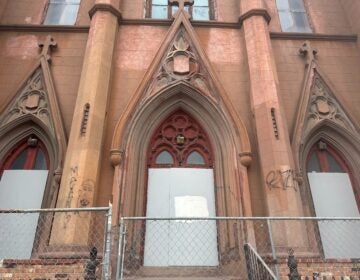Saucer Watch

As JFK Plaza/LOVE Park is redesigned by Hargreaves Associates this year, it is very much a live question as to whether or not the saucer-shaped building that serves as the Fairmount Park Welcome Center will be replaced or repurposed. That “or” has put the preservation community on alert. This week the space age welcome center landed on this year’s “Pennsylvania at Risk” list put out by Preservation PA, among seven threatened landmarks across the state. Last fall it was named one of four Places to Save by the Preservation Alliance of Greater Philadelphia.
But the more LOVE Park’s flying saucer is seen as threatened, the louder it seems the chorus becomes of those who think it ought to be razed.
To borrow a phrase from this year’s Valentine’s Day social media campaign by the Young Friends of the Preservation Alliance: #ThisJawnMatters. Our flying saucer matters.
It matters because of its architectural pedigree, a fine example of post-war municipal modernism designed by architect Roy Larsen, of Harbeson Hough Livingston & Larsen (now H2L2). It matters because it is one of our few urban renewal era buildings that successfully embodies the hope and progressive spirit of its time.
As Philadelphia reinvents itself in this era of urban growth, it’s tempting to erase vestiges of who we were. The knee-jerk reaction that new is automatically better is a lazy response to the welcome center in LOVE Park. As is the assumption that the park would certainly be better off without its saucer. That can only be determined in the context of the park’s new urban design at large, informed by careful study. We’re not there yet.
The burden of proof is now on the LOVE Park redesign team to demonstrate unequivocally that the building’s reuse is not possible. It will not be enough to say reuse is hard or it won’t generate enough revenue. (I happen to think it would make a spectacular snack stand/bar – floats by day, beer by happy hour.) Fortunately in HR&A’s revenue generation study of LOVE Park last year, they didn’t place all of the money-making burden on the building. It also helps that the saucer’s glassy, expressive modernism relates well to the café buildings Center City District has built in Cret, Dilworth, and Sister Cities parks, strung in a row down the Parkway. Strip away the stickers, decals, flags, and signage and the saucer could look fresh again.
Designers at Hargreaves and the architects from KieranTimberlake will need to exhaust alternatives to larding up the saucer building with every need of the park. They will need to think creatively about the saucer’s reuse, balanced against the rest of the site’s design demands. Among those demands are high sustainability standards for the renewed park. I hope that robust standard includes a life cycle analysis of the existing building – putting a value on its materials, its embodied energy, and the environmental cost of scrapping the saucer. Demolition tends to be more wasteful than it is sustainable.
Our old buildings, whether they’re 50 or 150, are not disposable and it is time Philadelphians stopped treating these assets as though they were cheap and irredeemable obstacles to progress. Creative constraints, maybe, but worth it. They’re the context in which we reinvent this city every day. They ground us in the very layers of time that makes old cities like ours architecturally rich and interesting.
I see the saucer as authentically us: Fragile, open, and optimistic in the face of a bright new urban century that’s being rapidly being reshaped by a taller, shinier, younger New Philadelphia. But shoot, back when, the saucer was New Philadelphia. Let’s not be so quick to dismiss that future of the past as passé.
WHYY is your source for fact-based, in-depth journalism and information. As a nonprofit organization, we rely on financial support from readers like you. Please give today.








